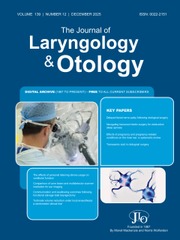No CrossRef data available.
Article contents
Coronavirus disease 2019 status and related anxiety levels in cases undergoing total laryngectomy
Published online by Cambridge University Press: 25 April 2024
Abstract
This study aimed to evaluate rate of the COVID-19 disease, its severity, mortality rate and anxiety levels in subjects who underwent total laryngectomy.
The subjects who underwent total laryngectomy were included in the study. The data were first obtained retrospectively and then a telephone survey was applied. Anxiety levels was evaluated by the Coronavirus Anxiety Scale (CAS).
A total of 54 subjects were included in the study. Nine (16.7%) males were reported to be infected with SARS-CoV-2. Five (55%) of them were hospitalized; 2 of them (22%) were taken to intensive care units, and one subject (11%) died. Although a tendency to increase risk of COVID-19 disease in the tracheoesophageal voice prosthesis users (23.1% vs 14.63%) was observed, statistically difference was not significant. The average total CAS score was significantly higher in those who had COVID-19.
The data documented that people who underwent total laryngectomy developed more frequent and more severe COVID-19 disease and had a higher mortality rate. Although no obvious variable was found, our data suggest that using a tracheoesophageal voice prosthesis may be somewhat effective. Besides, our subjects presented very low anxiety about COVID-19.
- Type
- Main Article
- Information
- Copyright
- Copyright © The Author(s), 2024. Published by Cambridge University Press on behalf of J.L.O. (1984) LIMITED
Footnotes
Burak Hazir takes responsibility for the integrity of the content of the paper


